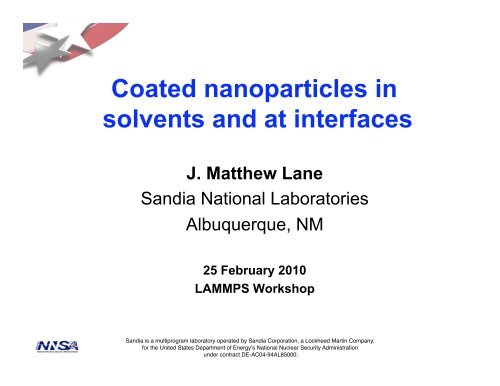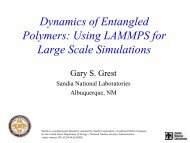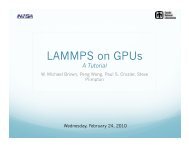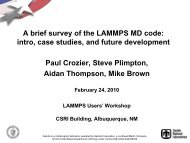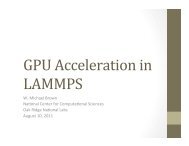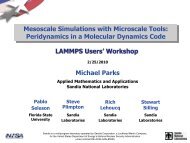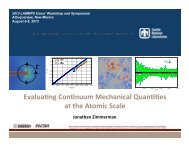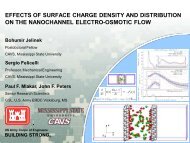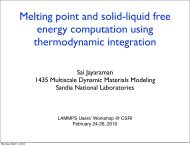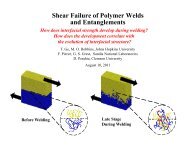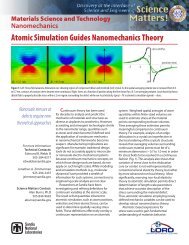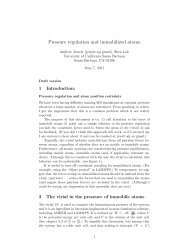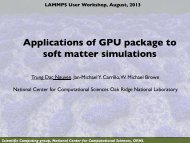Modeling nanoparticles in bulk and at surfaces - Lammps - Sandia ...
Modeling nanoparticles in bulk and at surfaces - Lammps - Sandia ...
Modeling nanoparticles in bulk and at surfaces - Lammps - Sandia ...
Create successful ePaper yourself
Turn your PDF publications into a flip-book with our unique Google optimized e-Paper software.
Co<strong>at</strong>ed <strong>nanoparticles</strong> <strong>in</strong><br />
solvents <strong>and</strong> <strong>at</strong> <strong>in</strong>terfaces<br />
J. M<strong>at</strong>thew Lane<br />
S<strong>and</strong>ia N<strong>at</strong>ional Labor<strong>at</strong>ories<br />
Albuquerque, NM<br />
25 February 2010<br />
LAMMPS Workshop<br />
S<strong>and</strong>ia is a multiprogram labor<strong>at</strong>ory oper<strong>at</strong>ed by S<strong>and</strong>ia Corpor<strong>at</strong>ion, a Lockheed Mart<strong>in</strong> Company,<br />
for the United St<strong>at</strong>es Department of Energyʼs N<strong>at</strong>ional Nuclear Security Adm<strong>in</strong>istr<strong>at</strong>ion<br />
under contract DE-AC04-94AL85000.
Courtesy of P. R. Schunk<br />
Problem description
System details<br />
Amorphous silica particles<br />
– 5 nm diameter<br />
– Tre<strong>at</strong>ed as rigid objects<br />
PEO cha<strong>in</strong>s<br />
– ca. 240 per 5 nm particle<br />
– Attached <strong>at</strong> OH sites<br />
W<strong>at</strong>er solvent used with PEO<br />
• Polyethylene oxide PEO(6)<br />
co<strong>at</strong>ed 5nm silica nanoparticle<br />
<strong>in</strong> w<strong>at</strong>er (3 cha<strong>in</strong>s/nm 2 )<br />
MD run details<br />
– T = 300 K<br />
– 10 Å cutoff on pair potentials<br />
– 4x10 5 – 7.2x10 6 <strong>at</strong>oms<br />
– Timestep 1fs – runs of 5-10ns<br />
Lane et al, PRE 79, 050501 (2009)
Interactions between <strong>nanoparticles</strong><br />
• Determ<strong>in</strong>e velocity <strong>in</strong>dependent (solv<strong>at</strong>ion)<br />
<strong>and</strong> velocity dependent (lubric<strong>at</strong>ion) forces<br />
- cha<strong>in</strong> length, nanoparticle size/shape, coverage<br />
• Integr<strong>at</strong>e <strong>in</strong>to coarse-gra<strong>in</strong>ed model
Interactions between <strong>nanoparticles</strong>
PEO-co<strong>at</strong>ed silica NP <strong>in</strong> w<strong>at</strong>er<br />
• PEO(20), 1.0 cha<strong>in</strong>s/nm 2 • PEO(100), 0.5 cha<strong>in</strong>s/nm 2<br />
• Mitra et al, Langmuir 19, 8994 (2003) – exp. - PEO(100), 0.2cha<strong>in</strong>s/nm 2
Construct<strong>in</strong>g model Au-thiol <strong>nanoparticles</strong><br />
Fact sheet:<br />
2, 4, <strong>and</strong> 8 nm diameter core with Au implicit<br />
S-(CH 2 ) 9 -X <strong>and</strong> S-(CH 2 ) 17 -X where X = CH 3 or<br />
COOH<br />
Simple structure of 60, 240 <strong>and</strong> 960 rigid graft<strong>in</strong>g<br />
sites from fullerene structure<br />
Constant coverage density of 21 Å 2 per cha<strong>in</strong><br />
• D. Dunphy, UNM/S<strong>and</strong>ia personal communic<strong>at</strong>ion<br />
Place each <strong>in</strong> decane, w<strong>at</strong>er <strong>and</strong> Brownian<br />
solvents.
2 to 8 nm co<strong>at</strong>ed nanoparticle cores<br />
8 nm diameter 4 nm diameter 2 nm diameter<br />
decane implicit w<strong>at</strong>er decane implicit w<strong>at</strong>er decane implicit w<strong>at</strong>er<br />
C10-<br />
CH 3<br />
C10-<br />
COOH<br />
C18-<br />
CH 3<br />
C18-<br />
COOH
Geometry as a control parameter<br />
l<br />
r<br />
• Particle size, r <br />
• Cha<strong>in</strong> length, l<br />
• Change <strong>in</strong> free volume per cha<strong>in</strong><br />
l
Geometry as a control parameter<br />
l<br />
r<br />
• Particle size, r <br />
• Cha<strong>in</strong> length, l<br />
• Change <strong>in</strong> free volume per cha<strong>in</strong><br />
l
Effect of mixed-cha<strong>in</strong> term<strong>in</strong><strong>at</strong>ion<br />
Co<strong>at</strong><strong>in</strong>g term<strong>in</strong><strong>at</strong>ion is an<br />
important secondary variable<br />
Bundl<strong>in</strong>g:<br />
• Mixed-cha<strong>in</strong>s decreased<br />
uniformity <strong>in</strong> the co<strong>at</strong><strong>in</strong>g<br />
surface<br />
• Mixed cha<strong>in</strong>s tended toward<br />
small tight bundles unless<br />
solv<strong>at</strong>ed
Effect of solvent <strong>and</strong> backbone<br />
decane<br />
implicit<br />
C18-COOH<br />
C18-CH 3<br />
Solvent quality is another<br />
important secondary variable<br />
Homogeneous cha<strong>in</strong>s behaved<br />
largely as expected to solvent<br />
changes based on hydrophilic/<br />
phobic <strong>in</strong>teractions<br />
w<strong>at</strong>er<br />
Mixed-cha<strong>in</strong>s deceased uniformity<br />
<strong>in</strong> the co<strong>at</strong><strong>in</strong>g surface as cha<strong>in</strong>s<br />
tended toward small tight bundles<br />
unless solv<strong>at</strong>ed
Surface <strong>in</strong>itial conditions<br />
• NPs placed <strong>at</strong> liquid/<br />
vapor <strong>in</strong>terface of w<strong>at</strong>er<br />
• All 12 particle type were<br />
began equilibr<strong>at</strong>ed <strong>in</strong><br />
implicit solvent<br />
• Simul<strong>at</strong>ion cont<strong>in</strong>ued until<br />
vertical motion ceased
Co<strong>at</strong>ed particles <strong>at</strong> a w<strong>at</strong>er surface<br />
C10 with CH 3 C10 with COOH C18 with CH 3 C18 with COOH<br />
2 nm<br />
diameter<br />
4 nm<br />
diameter<br />
8 nm<br />
diameter
Future direction: Surface <strong>in</strong>teraction<br />
• How will collections of particles behave <strong>at</strong> the surface?<br />
• Can we preselect drivers of self-assembly by alter<strong>in</strong>g the<br />
particle co<strong>at</strong><strong>in</strong>gs?<br />
COOH term<strong>in</strong>al group<br />
CH 3 term<strong>in</strong>al group
Summary <strong>and</strong> conclusions<br />
• Nanoscale forces between functionalized NPs can be<br />
found from fully-<strong>at</strong>omistic simul<strong>at</strong>ions<br />
– Contact forces between NPs are velocity & separ<strong>at</strong>ion dependent<br />
– Co<strong>at</strong><strong>in</strong>gs remove fe<strong>at</strong>ures of bare NPs – make more like macroscopic<br />
– The important regime for NP <strong>in</strong>teractions <strong>in</strong> solution is F < 1nN<br />
mak<strong>in</strong>g accur<strong>at</strong>e force extraction difficult<br />
– Coarse-gra<strong>in</strong>ed NPs will allow study of longer time <strong>and</strong> length scales<br />
• Co<strong>at</strong><strong>in</strong>g quality can be dram<strong>at</strong>ically affected by geometry<br />
<strong>and</strong> secondarily by co<strong>at</strong><strong>in</strong>g <strong>and</strong> solvent <strong>in</strong>teractions<br />
• “Poor” co<strong>at</strong><strong>in</strong>gs could be exploited <strong>at</strong> <strong>surfaces</strong> <strong>and</strong> <strong>in</strong> the<br />
<strong>bulk</strong> to select structures dur<strong>in</strong>g self-assembly<br />
• Resources now available to make significant <strong>in</strong>roads <strong>in</strong><br />
underst<strong>and</strong><strong>in</strong>g nanoparticle suspensions
Collabor<strong>at</strong>ors<br />
• S<strong>and</strong>ia:<br />
Gary Grest,<br />
Ahmed Ismail,<br />
Michael Ch<strong>and</strong>ross,<br />
Jeremy Lechman,<br />
Steve Plimpton<br />
• S<strong>and</strong>ia/UNM: P. R<strong>and</strong>al Schunk,<br />
Tim Boyle<br />
• Univ of Utah: M<strong>at</strong>t Petersen<br />
• K<strong>in</strong>g’s College: Christian Lorenz


